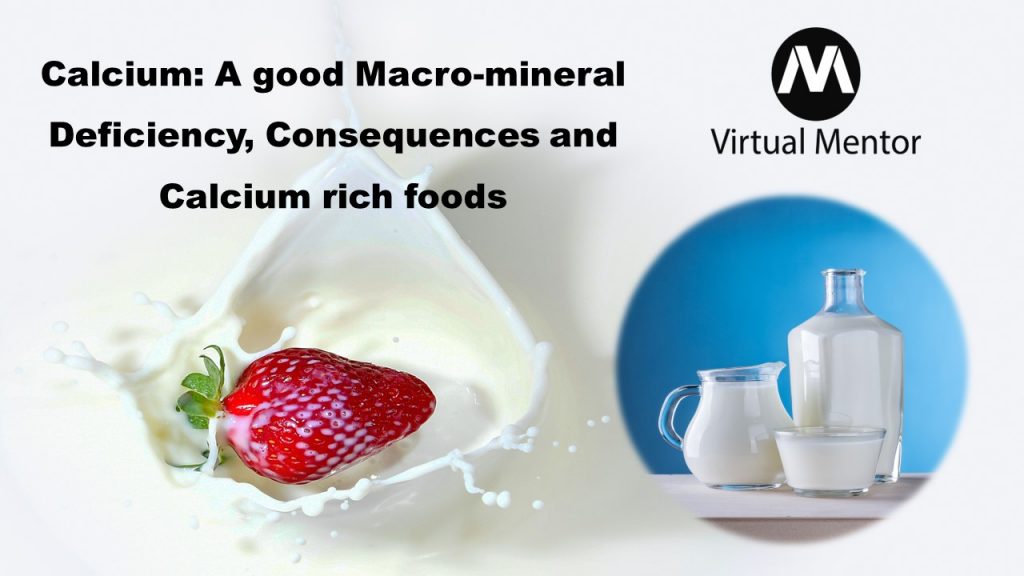What are macro-minerals?
The minerals required for the human body in large amounts such as 100 mg/day or more are called macrominerals. These include calcium, phosphorous, sulfur, sodium, chloride, and potassium. Those minerals which are needed much less amount are called microminerals. These include iron, copper, zinc, iodine, manganese, selenium, and fluoride.
Calcium:
Calcium is a micromineral and the human body consists of about 2 % calcium. Calcium has great metabolic and physiological importance because a large number of human biological activities depend on calcium. About 98 % of the calcium is present in the bones of humans, the rest 2 % is found in other tissues such as blood, muscles, etc.
Hormonal regulation:
Calcium is principally regulated by three two hormones: one is calcitonin and other is parathormone:
- Calcitonin (Also called thyrocalcitonin): It is a hormone that is released from thyroid glands and lower blood calcium by deposition in osseous tissue(bone). Calcitonin work until the homeostatic level of calcium is balanced in the blood & body.
- Parathormone: it is also an endocrine hormone released from parathyroid glands. Parathormone raises blood calcium by releasing from bones, reabsorption from kidneys tubule, and absorbing from the intestine. Parathormone also restores a homeostatic level of calcium in the blood.
Vitamin D3 and Calcium regulation:
1,25-Dihydroxyvitamnin (D3) is a fat-soluble vitamin that promotes the absorption of calcium and phosphorous in the osseous tissue and is necessary for the development of bone and teeth.
Role of Calcium:
- Bone and teeth Development:
The matrix of the bone is hardened by calcium phosphate makes bone suitable for its roles such as protection, support, maintenance of shape, and movements. Bones store calcium in the form of inorganic salts like calcium carbonate & calcium phosphates. When there is a need for calcium or phosphorous, endocrine control metabolic protocols release calcium according to the need of the body. Bones are also reservoirs of calcium where it is present in the form of calcium salts.
- Nerve Impulse Transmission:
Calcium is involved in the transmission of nerve impulses. When the nerve impulse reaches the synapse it results in the influx of calcium ions in the presynaptic neuron, which fuses the neurotransmitter vesicle with the presynaptic membrane releasing neurotransmitters by exocytosis. This neurotransmitter then binds with the postsynaptic neuron membrane which initiates the nerve impulse in the postsynaptic neuron.
- Muscular Contraction:
Calcium is necessary for muscular contraction because calcium-dependent switch Troponin doesn’t work without calcium. This switch actually controls muscular movement. During muscular contraction SER release calcium and during the relaxation phase this calcium is again pumped back into the SER. The nervous system regulates this calcium level in the muscle and control contraction and relaxation.
- Cardiac Cycle:
Calcium is very important for the rhythmical contraction of the human heart. It is essential for the initiation of electrical signals as well as the contraction of cardiac muscle.
- Blood pressure regulation:
Calcium is important in vasoconstriction and vasodilation, as calcium concentration is the smooth muscles of blood vessels increase, they tighten, and blood pressure increases. When vessels dilate, the blood pressure decreases.
- Essential for mechanisms the blood clotting;
Blood clotting is a complex phenomenon and it requires 13 blood clotting factors, calcium is one of them. Calcium is called Blood clotting factor (IV). It is very necessary to start blood clotting protocol sequences on cuts or damage to blood vessels.
Calcium-Rich Food:
- Dairy products: Milk, yogurt & cheese
- Meat
- Fish
- Green leafy vegetables
- Figs
- Broccoli
- Almond
- Soybean
- Egg
- Oranges
- Berries
- Oranges
Deficiency of calcium:
Following are the major problems associated with the low level of calcium in the body.
- Osteoporosis
- Dental problems
- Cataracts
- Hypocalcemia
- Muscular aches and spasms
- Laryngospasm
- Tetany
- Seizures
- Nervous problems (memory loss, confusion, lethargy)
- Psychological issues (depression & hallucinations)


Excellent article. I certainly love this website. Keep writing!